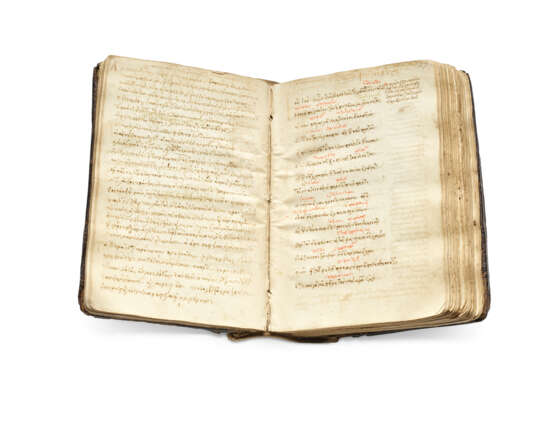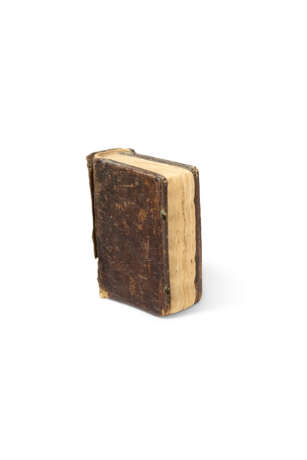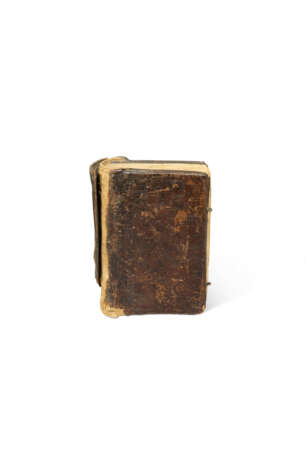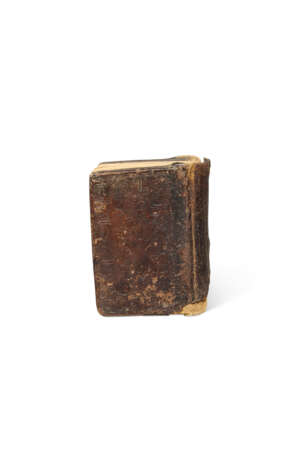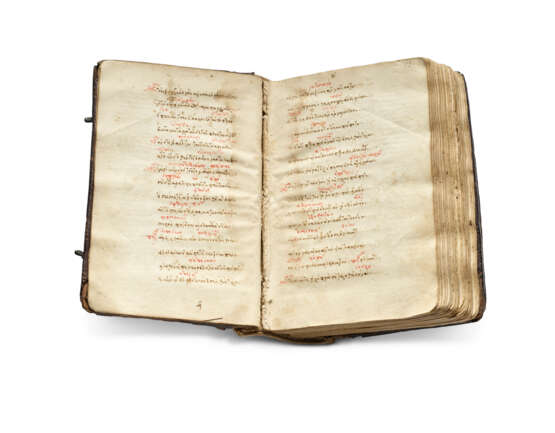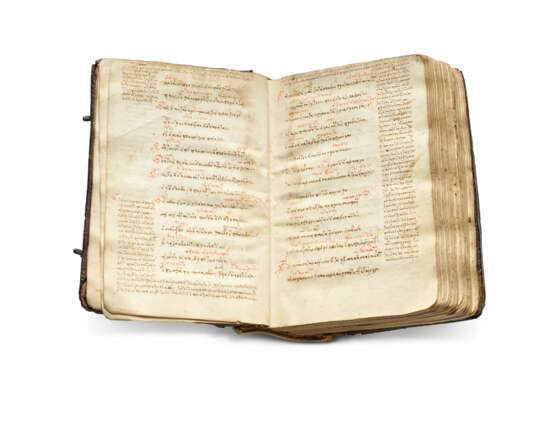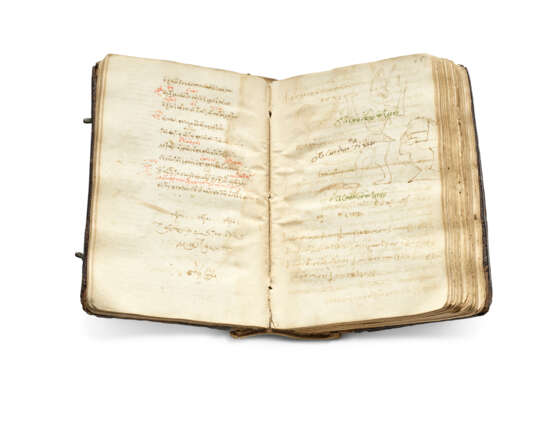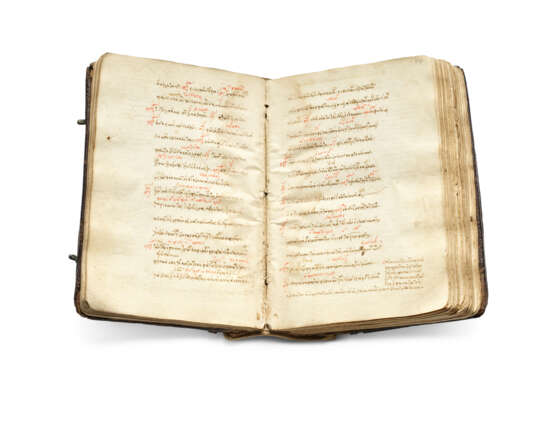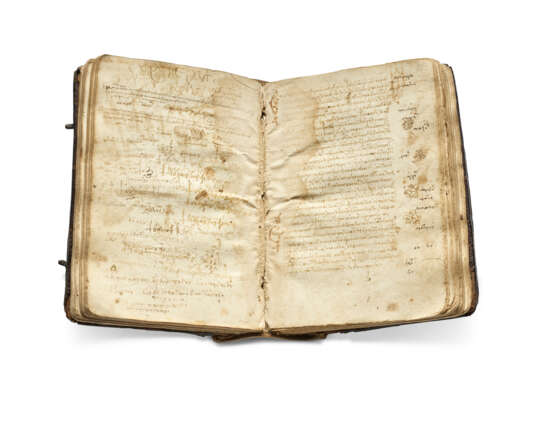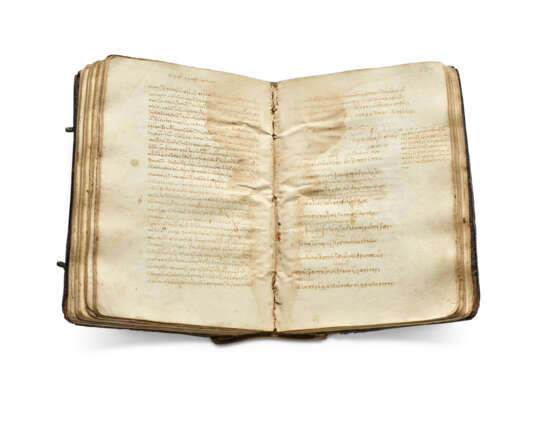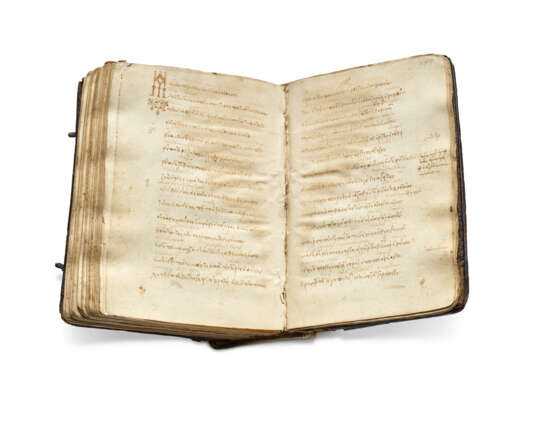ID 1214858
Лот 42 | An essential compilation of Greek literature
Оценочная стоимость
£ 150 000 – 250 000
Aristophanes (446-386 BCE), Plutus and The Clouds; Euripides (c.480-406 BCE), Hecuba and Orestes; Hesiod (c.750-650 BCE), Works and Days, in Greek, manuscript on paper [Crete?, second half 15th century]
An essential compilation of Greek literature: two plays by the Father of Comedy, Aristophanes; two by the greatest of Ancient tragedians, Euripides; and Hesiod's Works and Days, one of the earliest extant Greek didactic poems. In its contemporary Cretan binding.
203 x 130mm. 227 leaves, collation: 14, 27 (of 8, lacking i), 3-128, 134, 147 (of 8, i a cancelled blank), 15-168, 176 (of 8, i-ii cancelled blanks), 187 (of 8, viii a cancelled blank), 19-258, 2610, 277 (of 8, i a cancelled blank), 28-298, 307 (of 8, viii a cancelled blank), modern foliation 1-227 followed here, 15 lines written in a Greek minuscule in brown ink by several scribes, two lines of musical notation on f.56 (see below), some headings in red, scholia of Thomas Magister, Manuel Moschopoulos, and other Byzantine commentators, additions, marginal and interlineal glosses throughout, scribbles, doodles and sketches, including of faces, dancing figures, fish, birds and board games on ff.69, 94v-96 and 196v-197, a few notes in Latin, gathering signatures survive, watermarks versions of Briquet 14872, 6053, and 2563, see Provenance (lacking 1 leaf of text, else apparently complete, dampstaining throughout especially affecting gutter and inner margin, thumbed and stained, final blank leaves frayed and wormholed).
Binding:
Contemporary blind-stamped Byzantine binding of leather over thick wooden boards, Byzantine linked sewing and endbands, two brass pins projecting from edge of upper cover, remnants of leather clasps surviving on outer lower board, with corresponding knotted leather splits emerging on the inside (worn and rubbed, edges scuffed, spine partly defective and flapping open to reveal hessian lining underneath). In a fitted box.
There are several tools present on the binding: (a) a triangle with a winged dragon, (b) a circle with a large fleur-de-lys, (c) a triangle with two birds facing a plant above a scroll, (d) a rectangle with two birds among foliage, (e) a round-cornered square with a small arabesque, (f) a larger square with an elaborate arabesque, and (g) a rectangle with three rosettes within scrolling foliage. The most distinctive of these, the winged dragon and the fleur-de-lys, correspond to Irigoin nos 9 and 14 and are to be found on the bindings of a group of manuscripts connected with the Cretan scriptorium of Michael Apostolis in the second half of the 15th century (on these bindings, see J. Irigoin, 'Une groupe de reliures crétoises (XVe siècle)', Κρητικά Χρονικά 15-16.2 (1961-2), Heraklion, 1963, pp.102-112 and pl.3-6; and S. Pugliese, 'Byzantine Bindings in the Marciana National Library', The Book in Byzantium. Byzantine and Post-Byzantine Bookbinding (Proceedings of an International Symposium, Athens, 13-16 October 2005), 2008, pp.222-226). Irigoin notes (p.108) that the dragon appears on all 8 of the Cretan manuscripts he studied; four of these also feature the fleur-de-lys (these also appear on Rome, Biblioteca Apostolica Vaticana, Vat. gr. 1585, not described by Irigoin). The larger square with arabesque (b) and the rectangle with three rosettes (g) are noted in other Byzantine bindings by F. Macchi, 'Una legatura bizantina alla Biblioteca Queiniana', p.33. A further common feature are the knotted leather splits surviving on the inside lower boards, and the brass pins where the catches would have affixed. On Byzantine binding, see K. Choulis, 'La legatura dei manoscritti greci nel periodo bizantino e post-bizantino. L’origine, la storia, le tecniche di manifattura', Scrittura e libro nel mondo greco-bizantino, 2012, pp.181-206).
Provenance:
(1) The tools on the contemporary binding suggest that the manuscript was produced in Crete in the workshop of Michael Apostolis in the second half of the 15th century. The watermarks (Briquet 14872, 6053, and 2563) are all from Venetian paper stock of around the same date: given the fervent intellectual and mercantile exchange at the time, it was perfectly common for Italian-made paper to be used in Byzantine/Cretan productions, especially since Crete (Candia) was an overseas colony of Venice.
(2) Richard Johnson Walker (1868-1934), Anglican clergyman, schoolmaster and local politician. In his possession by 1911, when he published an article identifying two lines of musical notation at v.275 of The Clouds (f.56) in the present copy, see Walker, 1911.
(3) Sir David Victor Kelly (1891-1959), British Minister to Switzerland and later Ambassador to Argentina, Turkey and the Soviet Union: his sale as 'The Property of D. V. Kelly, Esq.' at Sotheby's, 5 March 1935, lot 281, for £28 to:
(4) Ernst Philip Goldschmidt (1887-1954), Viennese-born antiquarian bookseller in London. Sold for £105 to:
(5) John Alfred Spranger (1889-1968), pioneering archaeological photographer.
(6) Sotheby's, 5 December 1989, lot 73, sold for £88,000 to:
(7) Schøyen Collection, MS 593.
Contents:
Blanks ff.1-4; Aristophanes, Plutus, lacking first leaf and opening in line 29: '[...] ἐγὼ θεοσεβὴς καὶ δίκαιος ὢν ἀνὴρ', ff.5-45v; the Argumentum for The Clouds of the 13th-century Byzantine scholar and grammarian Thomas Magister, beginning 'Ανυτος και μελιτος Σωκρατει' f.46v; The Clouds ff.47-94; 'Life of Euripides' of 13th/14th century Byzantine commentator Manuel Moschopoulos (Suda ε 3695), beginning: 'Εὐριπίδης, Μνησάρχου ἢ Μνησαρχίδου καὶ Κλειτοῦς' f.96; the Argumentum for Hecuba, beginning 'Mετὰ τὴν Ἰλίου πολιορκίαν', f.96v; Euripides, Hecuba ff.97-138; the Argumentum for Orestes beginning: 'Ὀρέστης τὸν φόνον τοῦ πατρὸς', f.138v; Orestes ff.139-195; notes on meter f.197v; the Argumentum for Works and Days f.198; Hesiod, Works and Days, ff.198v-225; blanks ff.226-227.
The manuscript assembles important texts of three monuments of Greek literature. The individual texts are well represented in European institutions: around 240 manuscript copies of Plutus survive; c.190 copies of The Clouds; c.390 of Hecuba; c.230 of Orestes; and c.270 of Work and Days. In spite of this, there are no copies of Aristophanes or Euripides recorded in North American institutions, and only 4 of Hesiod's Works and Days (Harvard, Houghton Library, MS. Gr. 20; New Haven, Beinecke Rare Books and Manuscript Library, MSS 254 and 289; and New York, New York Public Library MA 99). With the exception of the present copy, no manuscript of Aristophanes or Euripides has appeared at auction in at least a century.
Plutus is the last of Aristophanes' extant plays. It is the story of the elderly, honest and poor Chremylos who is instructed by Apollo to follow the first man he meets and persuade him to come home with him. This turns out to be Plutus, the god of wealth, who appears to him as a blind beggar. The Clouds is widely recognised as the first 'comedy of ideas', and is still to this day one one of the finest examples of the genre. It is a lampooning of intellectual fashions in Athens in which the foolish old farmer Strepsiades finds himself the pupil of Socrates who can prove by debate that the worst cause is the better. It remains notorious for its caricature of Socrates, who is presented as a petty thief, a fraud and a sophist, and is cited by Plato in the Apology as a contributing factor to the philosopher's trial and execution. A fascinating feature of the present manuscript is the added musical notation in red above v.275 (f.56), first identified by R.J. Walker in 1911 (Walker, 1911). Walker assumed that this a remnant of Alypian 5th-century notation, but in a riposte to his article, Théodore Reinach argues that it is most likely an example of contemporary 15th-century Byzantine notation (see Reinach, 1911).
The first of the two Euripidean tragedies represented in this manuscript is Hecuba, set in the aftermath of the Trojan War, which tells the story of how the Greeks' sacrifice of Hecuba's daughter, Polyxena, to the spectre of Achilles, and the subsequent death of her son Polydorus reduces the aged Trojan queen, now a widowed slave, to ruthless revenge and animal ferocity. The second tragedy is Orestes, which tells the aftermath of Orestes’ matricide, and of how Orestes, his sister Electra, and his cousin and friend Pylades are condemned to death by the men of Argos for the murder. Their uncle Menelaus is too spineless to defend them, and they plot to kill Menelaus’s wife, Helen, and to abduct her innocent daughter.
The final text is the greatest work of the poet Hesiod, the earliest known Greek poet after Homer. Addressed to his brother Perses it is, at its core, a farmer's almanac and the first literary account of farming, set against a background of agrarian crisis in mainland Greece. Works and Days is perhaps best known for its two mythological aetiologies for the toil and pain that define the human condition: the story of Prometheus and Pandora, and the so-called Myth of Five Ages.
Literature
Reinach, T., 'Une ligne de musique byzantine', Revue Archéologique, Quatrième Série, T. 18 (July-December 1911), pp.282-289.
Walker, R. J., 'A fragment of Greek music', Oxford and Cambridge Review, July 1911, pp.113-119.
| Место происхождения: | Греция, Европа |
|---|---|
| Категория аукционного дома: | Манускрипты Средневековья и Ренессанса, Книги и рукописи |
| Место происхождения: | Греция, Европа |
|---|---|
| Категория аукционного дома: | Манускрипты Средневековья и Ренессанса, Книги и рукописи |
| Адрес торгов |
CHRISTIE'S 8 King Street, St. James's SW1Y 6QT London Великобритания | |
|---|---|---|
| Предосмотр |
| |
| Телефон | +44 (0)20 7839 9060 | |
| Комиссия | see on Website | |
| Условия использования | Условия использования |
